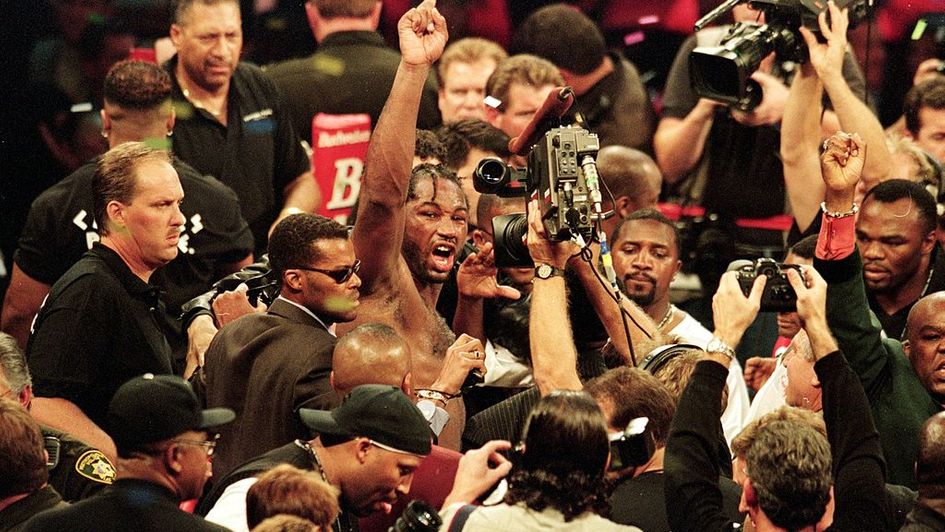Despite not everyone sharing his optimism, the irascible Eddie Hearn has insisted there is now “no reason” why Anthony Joshua’s world heavyweight unification showdown with Tyson Fury will not be signed, seal and delivered, with the fight expected to take place in Jeddah in Saudi Arabia on either August 7 or 14.
With the showdown between the UK’s finest so close, Furyjoshua.com looks at the changing perception of British heavyweights down the years.
This is undeniably a golden era for British big men in the prize ring. Indeed, you can make a legitimate case for Tyson Fury, Anthony Joshua and Dillian Whyte being the best three heavyweight fighters on the planet right now.
Boxing bible Ring Magazine has Fury at #No1, Joshua and #No2 and Whyte in at #No4 (just behind American Deontay Wilder at #No3) in its latest rankings. Pre-pandemic, huge audiences were flocking to watch boxing in Britain with AJ in particular setting attendance records for indoor and outdoor venues during his first world title reign.
By general consensus, the best big men of these shores are hugely respected and very well remunerated every time they go to war. Yet it wasn’t always so.
The history of British heavyweight boxers, right up to Lennox Lewis’ rise to the top in the 1990s, was inglorious. Seen as chumps as opposed to champs. A history of gallant failure.
For decades U.S. scribes and promoters loved to describe those who boxed north of 200lbs and hailed from the United Kingdom as "Horizontal Heavyweights". Indeed, for virtually all of the last century, British boxing fans had to endure ridicule and derision from American fight aficionados and media figures over the questionable quality and durability of our heavyweights.
93 years of heavyweight failure
In a nutshell, the inference was that British heavies lacked resilience and strength. They lacked the finesse and cojones to win the richest prize in sport. Indeed, it was 93 years between Bob Fitzsimmons losing the world heavyweight championship and Lewis being crowned WBC champion in 1992.
During that dark period, there were a dozen unsuccessful attempts to win the heavyweight championship. A colourful story of bravado, courage under fire, but always ending in defeat.
Joe Louis v Tommy Farr
Tommy Farr kicked things off in the 1930s with a game showing against the brilliant Joe Louis. The ‘Brown Bomber’ was an American idol in a simpler era, when athletes were heroes and sportswriters were adept in building legends rather than exposing them.
Farr took the fight to Louis in front of 40,000 fans at Yankee Stadium. The smart money was on Louis winning early, but a bloodied and battered Farr put up a truly gutsy effort and took the fight to the champion. In the end ‘The Tonypandy Terror' lost a decision, but gave a fabulous account of himself and won a moral victory in NYC.
Rocky Marciano v Don Cockell
Don Cockell was next, as he took on another American legend in Rocky Marciano in San Francisco in 1955. Cockell fought his heart out, but this was Marciano at his brutal and dirty best (or worst, if you were Cockell).
The brilliant Budd Schulberg described the fight in the pages of Sports Illustrated as follows:
“This was a bare-knuckle brawl with gloves - and not a pleasant sight either - as an uncouth, merciless, uncontrolled and truly vicious fighter (Marciano) wore down an ox-legged, resolute fat man who came into the ring with the honor of the British Empire weighing heavily - and consciously - on his massive, blubbery shoulders.”
In Marciano’s penultimate fight, he dished out a fearful beating before recording a TKO victory in the ninth. Cockell, defiant to the end, did somehow though finish on his feet.
(Brian) London falling
Hartlepool-born hard case Brian London was next to try his luck when he challenged Floyd Patterson in 1959. Patterson was guided by the brilliant Cus D’Amato and finished the job in 11 rounds. London was knocked out for the first time in his career but would pocket a career-high £20k purse for his trouble.
Cooper comes up short
Henry Cooper twice mixed it with Muhammad Ali, and on the second occasion, the WBC world heavyweight title was on the line at Highbury. Their 1966 clash lacked the drama of their first meeting, when ‘Enry’s Ammer’ had momentarily turned the boxing world upside down by decking a prime Ali (then Cassius Clay) at Wembley on June 16, 1963.
Their return was a lot more one-sided, with Cooper stopped on cuts in the sixth, his face a seeping blur of crimson. That Highbury bout drew a live gate of 46,000 spectators, and held the record for the largest live audience at a British boxing event right up until Joe Calzaghe and Mikkel Kessler drew 55,000 spectators to the Millennium Stadium in 2007.
Bugner can’t end the drought
Joe Bugner was next. He endured a torrid relationship with the British press, who he felt never forgave him for ending the career of the wildly-popular Cooper. In a professional career which lasted some 32 years, the broad-shouldered Bugner fought just about everybody at the top level.
He met ‘The Greatest’ Muhammad Ali twice (including once in a world-title challenge in the searing heat of Kuala Lumpur) and Joe Frazier once. Disproving the American view that all British heavyweights had no chin, he took his licks against both all-time greats and took both of them to the scorecards.
Hugh McIlvanney, the doyen of sports writing, memorably summed Bugner up when he said: “In his prime, Joe Bugner had the physique of a Greek statue, but he had fewer moves.”
Bugner’s demise as a top-level heavyweight was confirmed by Frank Bruno, who blasted him to defeat inside eight rounds at White Hart Lane in October 1987.
Bruno title bids
A year before that, in July 1986, big Frank had boxed Tim Witherspoon at Wembley Stadium for the WBA heavyweight crown, infamously coming apart in the penultimate stanza after a bright start.
Bruno’s next fight after Bugner was against Mike Tyson, for the WBC, WBA and IBF titles. The fight was postponed several times as Tyson’s personal life unravelled. Outside the ropes it was chaos for Tyson by this point, but the ring remained his sanctuary and few gave Bruno a chance of lasting three rounds.
He was on the floor inside the opening 20 seconds, but showed all the bravery and guts predecessors Farr and Cockell had previously displayed on US soil by picking himself back up and going toe-to-toe with Tyson.
He would find a huge left hook himself later in that wild first round, which caused the revered BBC commentator Harry Carpenter to launch into his iconic “Get in there, Frank!” line. For a brief moment there was a ‘suspension of disbelief’ so beloved of Hollywood moguls who make movies about flying men from the planet Krypton. Bruno was one punch from immortality, yet somehow Tyson survived the crisis and would go on to deliver a violent coup de grace in round five.
Seven years later the pair met again, with Bruno as WBC champion this time and Tyson looking to reclaim his seat on the heavyweight throne after a spell in the big house. Bruno crumbled in three at the MGM Grand, in a fight where he crossed himself more times walking to the ring than he threw meaningful shots at ‘Iron Mike’.
It was Bruno’s last fight, but also the last stand of the men seen in the United States as the ‘Horizontal Heavyweights’. While Frank did eventually hold a world title briefly before that second loss to Tyson, he was never really taken seriously across the pond.
Lewis would be the man to usher in a new era.
Lennox Lewis: the heavy who had it all
Until Lennox, British history in the weight class was largely one of failures. Some glorious. Some not so. Yet Lennox Claudius Lewis was cut from a different cloth. He may have won gold for Canada in 1988, but Lewis was born in West Ham, London, England to Jamaican parents.
His mesmerising mix of raw power and the sweet science completely changed the way America viewed British heavyweights, and after a few bumps in the road Lewis would eventually reign as ‘undisputed’ heavyweight champ in an era where the WBO belt was lightly regarded.
As the man himself said after announcing his retirement following a 2003 win over Vitali Klitschko: “The mission I set out on in the beginning - to become heavyweight champion of the world, undisputed, lineal champion - you could say that mission is complete.”
Fast forward to the present day, and British heavyweights now dominate the landscape. Joshua and Whyte do not have perfect ring CVs and both have been stopped, but they continue to evolve as top-tier fighters who do serious pay-per-view numbers.
Fury, ‘The Gypsy King’ has also been horizontal a few times during his remarkable career. Crucially though, nobody has been good enough to keep him down so far.
All things being equal AJ and Fury will meet for the ‘undisputed’ crown this summer and America, along with the rest of the world, will be forced to accept that there is nothing remotely ‘horizontal’ about UK heavyweights in the 21st Century.









